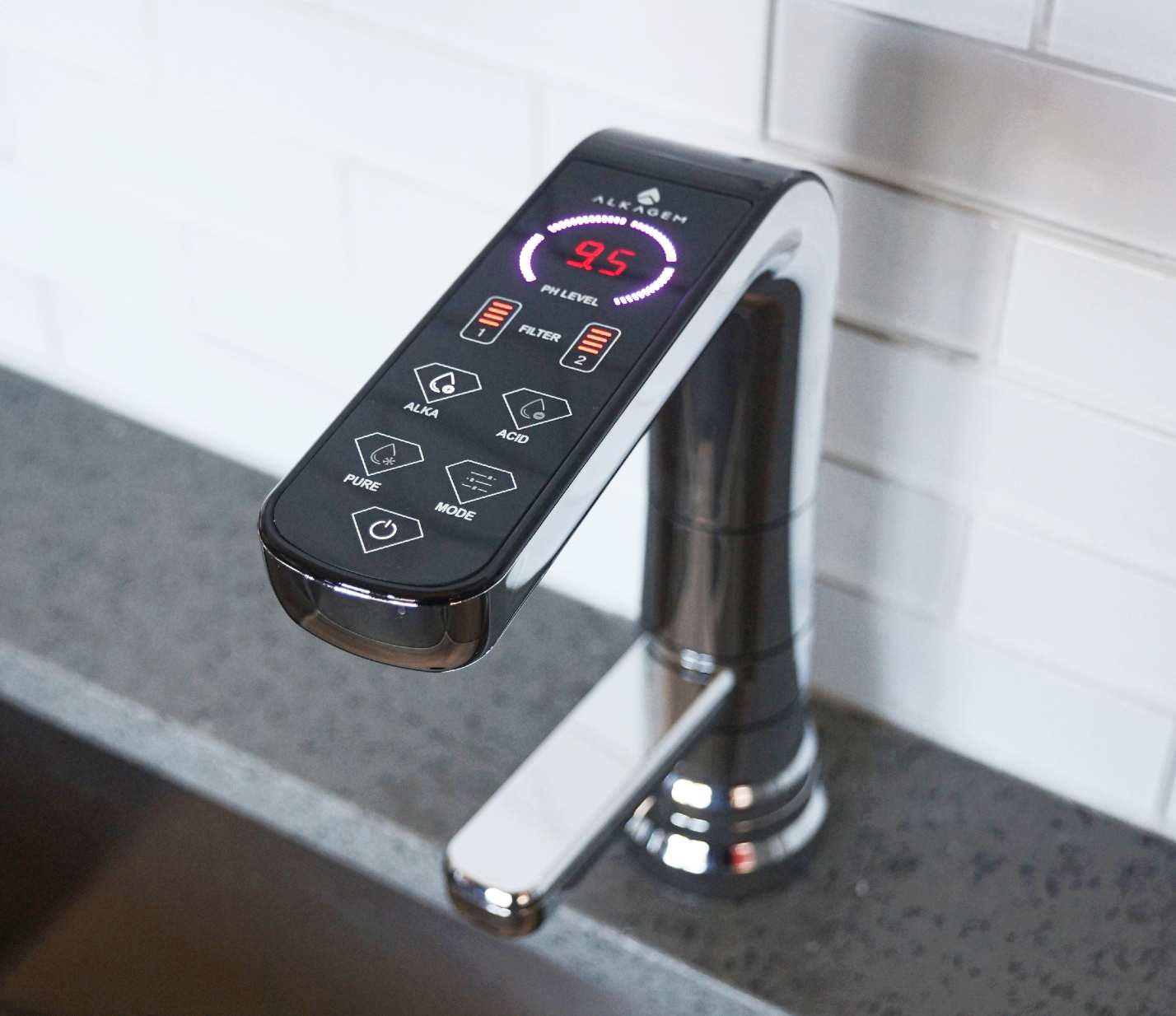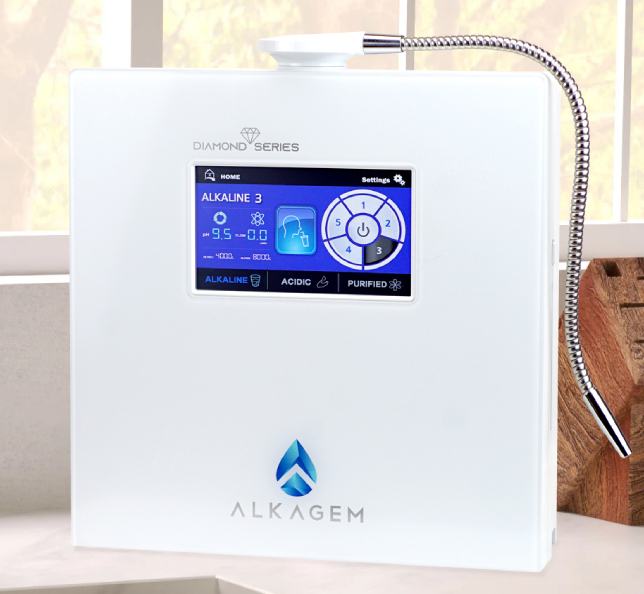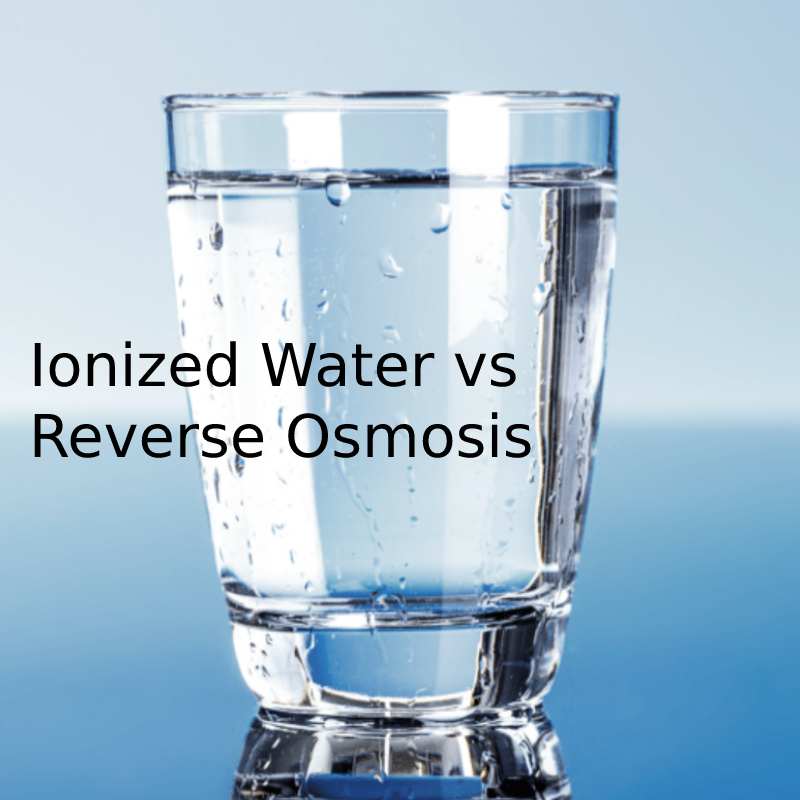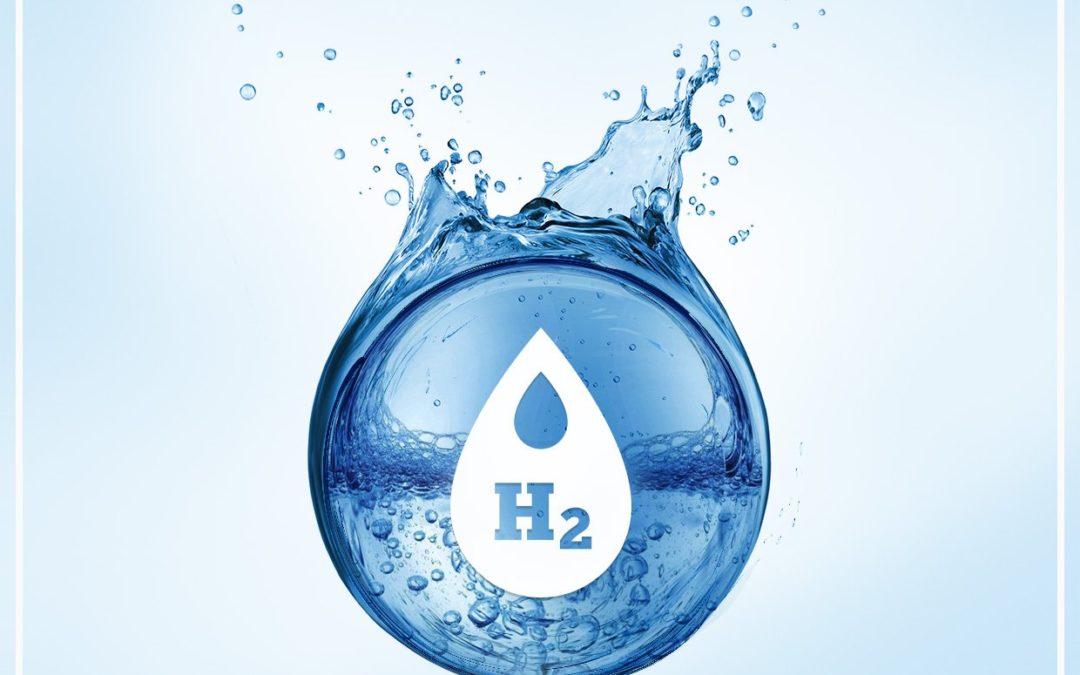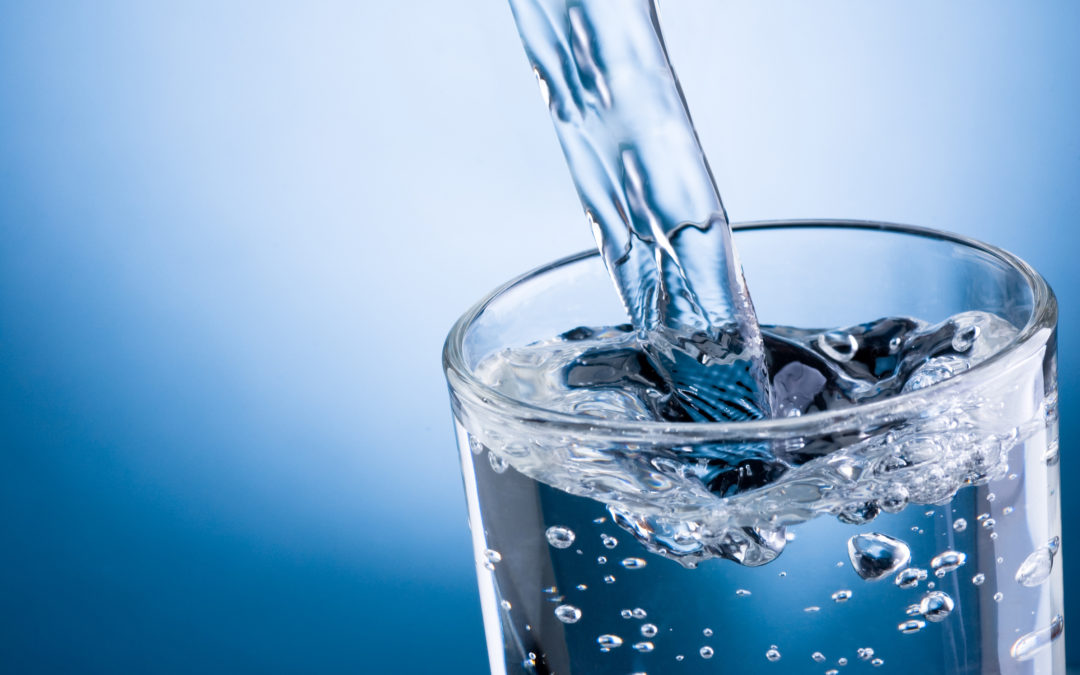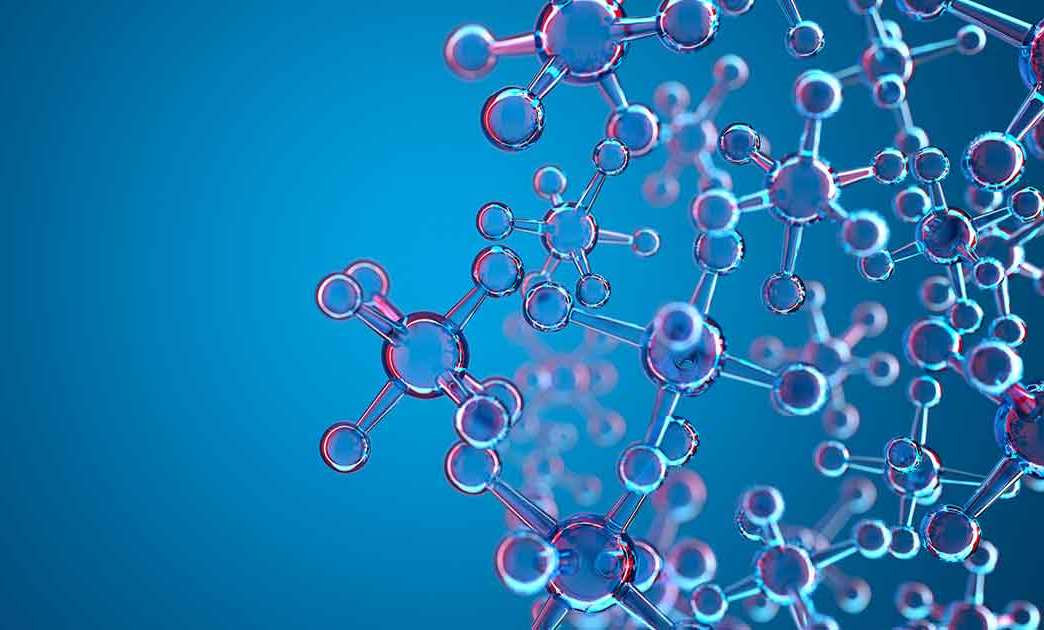Treating Water with Ionization vs Reverse Osmosis: Which is Better?
What is Ionization?
Ionization is a process used to treat water that filters out impurities, adds antioxidants, and allows you to customize alkalinity. A home water ionization machine such as Alkagem’s uses tap water from your kitchen, which first travels through 2 nanoparticle filters in order to remove toxic contaminants such as chlorine and lead. The filter allows beneficial alkaline minerals such as calcium, magnesium, and potassium to pass through. Next, the filtered water undergoes electrolysis by platinum-coated titanium electrode plates. This allows for the production of ionized alkaline water that is full of antioxidants without the use of chemicals. The process separates the hydrogen from the oxygen as shown in the following equation: 2H2O -> 2H2 + O2


Source: https://www.sciencedirect.com/topics/engineering/alkaline-water-electrolysis
There is a negatively-charged pole called the cathode, which attracts positively-charged H+ ions, and where the ionized alkaline water is collected. The reduction reaction that occurs at the cathode is represented by the chemical equation: 2H2O + 2e– → H2 + 2OH–
The active agents in this reduced water are active hydrogen (hydrogen atoms), hydrogen anions, hydrogen molecules, alkaline mineral nanoparticles, and alkaline mineral nanoparticle hydrides. The hydroxyl ions (OH–), alkaline minerals, and electrons present are responsible for the elevated pH (alkalinity) and negative ORP (antioxidant potential). This water is used for drinking and has many proven health benefits.
There is also a positively-charged pole called the anode, which attracts negatively-charged hydroxide ions (OH-), and creates ionized acidic water. This water has sterilizing properties due to hypochlorous acid, chlorine gas, and ozone content. This is an oxidation reaction represented as: 2OH– → 1/2O2 + H2O + 2e– (Kecebas et al., 2019)
These processes occur in a matter of seconds. The machines allow you to quickly convert ordinary tap water into filtered, ionized water at any pH setting, for use in drinking, cooking, cleaning, sterilizing, etc. (Alkagem, 2021)
What are the Health Benefits of Drinking Ionized Alkaline Water?
The health benefits of drinking ionized alkaline water have been studied and reported in the literature since the 1930s. Eastern medicine has used this water to treat illness and disease for centuries. Today, it is commonly used in Asian medical centers to help combat oxidative-stress-related diseases such as cancer, arteriosclerosis, neurodegenerative disease, gastrointestinal problems, diabetes, chronic fatigue, sleep disorders, and generalized pain disorders; to name a few. Water electrolysis machines are now becoming more commonly used in Western medicine and in the homes of the health-conscious around the globe. More recently, the benefits to athletes have been realized and put into practice in training facilities and the homes of professional athletes across the world. (Shirahata et al., 2012)
How exactly does this water benefit our bodies? It’s all about molecular hydrogen (H2). With an atomic number of 1, hydrogen is the smallest element on the periodic table. In fact, it is such a tiny molecule that it can even penetrate the blood-brain barrier. Every H2 molecule has 2 free electrons, one of which gets donated to any nearby free radical, thus stabilizing and neutralizing it. Free radicals lead to oxidative stress, DNA damage, aging, and disease. Substances that neutralize free radicals are called antioxidants. The amount of antioxidants present is measured by a unit called ORP (oxidation reduction potential). The higher the negative number, the stronger the antioxidant power. (Ohta, 2014)
Human blood has a pH of 7.2-7.4. The body works very hard to maintain this range. A slight elevation in blood pH causes hemoglobin to release more oxygen to surrounding cells and tissues. This flooding of oxygen leads to feelings of less fatigue, more energy, reduced pain, and increased athletic performance. Ionized alkaline water is known to increase ATP production (more energy) and aid in lactic acid removal (shortened recovery time).
Proteins (the essential building blocks of all living things) rely on hydrogen bonds to maintain their shape. Proteins cannot perform their assigned function in the body without folding into a precise structure and keeping that shape. Hydrogen bonds attach the building blocks of proteins, called amino acids, together. (Brennan, 2018)
Finally, the water from ionization machines is ultra-hydrating because of micro-clustering. The ionization process restructures the water molecule clusters so that they are smaller and hexagonally shaped, allowing them to permeate cells more efficiently and effectively, leaving you more hydrated and refreshed with less bloating. Bottled water generally has 12-14 molecules per cluster, whereas ionized alkaline water contains only 4-6 molecules per cluster. Think of it like throwing a softball at a net versus shooting a BB gun at it; the BBs go right through. You do not need to consume as much water throughout the day when it is ionized alkaline water. Consuming ionized alkaline water leads to better cellular, organ, and protein function; ultimately translating to overall better health and performance with less disease and signs of aging. (Ichihara et al., 2015)
Let’s Review the Benefits of Ionized Alkaline Water:
- It’s full of molecular hydrogen, a powerful antioxidant
- It’s ultra-hydrating
- It has a naturally high pH (it’s alkaline) without the need for chemicals
- It’s full of essential minerals like calcium, magnesium, and potassium
- It’s double filtered for harmful contaminants
- It has a many research-backed and proven health benefits
- A home machine is affordable and easy to install and maintain
- No waste
- It’s quick and dispenses drinking water straight from there unit
What is Reverse Osmosis?
Reverse osmosis was first used in the US on a large scale in the 1970s to desalinate brackish or seawater in order to make it potable. It involves using mechanical pressure to force water through a semipermeable membrane which blocks undesirable components such as sodium molecules.
In regular osmosis, solvents move from areas of low solute concentration to areas with higher solute concentration, reducing the Gibbs free energy of the system by decreasing the difference in solvent concentrations on both sides of a membrane. It is driven by osmotic pressure. In reverse osmosis, external/mechanical pressure is used to reverse the natural flow, forcing the solvent from areas of high solute concentration to areas with lower solute concentration. Pressure and concentrations are linked; the higher the concentration differences become, the more pressure is needed. (Wiles & Peirtsegele, 2018)

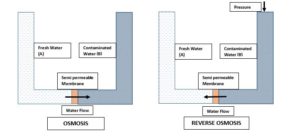
Source: https://www.arhse.com/reverse-osmosis-for-water-treatment/
Reverse osmosis does a very good job of removing solvents, but unfortunately, it removes beneficial minerals such as calcium, magnesium, and potassium too. It does not remove small molecules like chlorine, pesticides, and pharmaceutical compounds, so most home reverse osmosis systems add activated carbon filters to remove these contaminants. Reverse osmosis also does not always remove all microbes so sometimes a UV sterilizer is also needed. Home reverse osmosis filtration systems also generally require one or two sediment filters. These systems are very complicated and expensive, often necessitating the professional installation of 8 or more components. The drinking water produced must sit in a holding tank. If that is emptied, you must wait for it to refill.

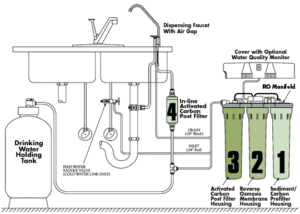
Source: https://kraaiwelldrilling.com/how-do-reverse-osmosis-systems-work/
Not only are these home reverse osmosis systems costly to purchase and install, because there are so many delicate parts, frequent maintenance and repairs are required. Because so much pressure is needed to force the water against its natural osmotic pressure, they also waste a lot of water and energy.
Is Drinking Reverse Osmosis Water Really Bad for Me?
Reverse osmosis has many industrial, medical, and domestic applications, but the demineralized water it produces makes for terrible drinking water. Reverse osmosis was first used out of necessity and in the face of a lack of better affordable options. It is now considered a last resort and only used where it is the only available option.
The WHO has warned that long-term consumption of reverse osmosis drinking water by humans has negative health effects. European countries have banned using reverse osmosis to process natural mineral water.
Let’s look at some of the research regarding the negative health effects of consuming reverse osmosis water. The journal titled Environmental Science and Technology has published several statements by leaders in the field regarding concerns around the health of populations around the world consuming reverse osmosis-treated drinking water. (Naser et al., 2019)
Drinking demineralized water was found to be associated with higher blood pressure and hypertension risks in those coastal populations of Bangladesh where reverse osmosis is used. This is because the missing essential minerals, calcium and magnesium, keep blood pressure low. (Naser et al., 2019)
Schlezinger et al. (2018) found that “Long-term consumption of desalinated reverse osmosis water, unless remineralized in the process, may have profound detrimental health consequences, particularly cardiovascular. The incidence of ischemic heart disease was higher in areas served by desalinated water in Israel compared to areas served by nondesalinated water.”
Gupta et. al. (2016) concluded that “Use of reverse osmosis processed drinking water was associated with Vitamin B12 deficiency” in their cross-sectional study from Western India. Vitamin B12 deficiency is a serious health risk known to cause macrocytic anemia, peripheral neuropathy, dementia, weight loss, neural tube birth defects, and various other adverse health effects.
Payment, et. al (1991) raised concerns regarding GI health problems in families using home reverse osmosis systems due to excessive bacterial growth inside the units. They also looked into the idea that drinking reverse osmosis water can lead to electrolyte imbalance. They concluded that drinking excessive amounts of demineralized water will cause electrolytes to leach from our tissues leading to fatigue, muscle cramps, weakness, headaches, and abnormal heart rate. Mountain climbers drinking unmineralized melted snow faced brain swelling, convulsions, and metabolic acidosis.
Minerals from water are better absorbed than minerals from food due to the complex chemical forms and interference with other chemicals in foods. The minerals in water are present in simple ionic forms that facilitate high absorption. (WHO, 2009)
Saini (2017) stated that reverse osmosis water is “highly aggressive” and attacks pipes and storage tanks, causing heavy metals and other contaminants to leach into the water supply. Reverse osmosis water is unstable and quickly becomes acidic due to the absorption of carbon dioxide from the air. He also pointed out that reverse osmosis water has an unfavorable taste and is generally considered “bitter”. His review of the literature found that the reduced intake of calcium and magnesium by those consuming reverse osmosis-treated water has been linked to osteoporosis, hypertension, cardiovascular disease, diabetes, motor neuronal disease, pregnancy complications, and even some types of cancer.
Let’s Review the Pitfalls of Reverse Osmosis Water:
- It has no antioxidants
- It doesn’t hydrate well and can lead to electrolyte imbalance
- It becomes acidic very quickly
- It is stripped of all minerals, even those essential for human health
- It does not always filter bacteria and can lead to GI illness
- Its consumption has been shown in research to lead to many health problems
- A home machine is expensive, complicated, and requires professional installation and regular maintenance and repairs
- It wastes a lot of water and energy
- It’s slow and requires a holding tank
Ionized Water is Better for Your Health Than Reverse Osmosis Water
We all know that we need additional water filtration systems in our homes. There are clear health and financial advantages to using ionization as your home water filtration system over reverse osmosis. It is the only way to get filtered alkaline drinking water full of health-promoting antioxidants. Visit us at Alkagem.com to learn more about our ionization machines.
References
Alkagem. (2021, October 10). Understanding the Water Electrolysis Process. Alkagem.com. https://www.alkagem.com/understanding-the-water-electrolysis-process/
Brennan, J. (2018, May 15). The Effects of Hydrogen Ions on Humans. Sciencing.com. https://sciencing.com/type-changes-ph-living-organisms-8647730.html
Calcium and magnesium in drinking-water Public health significance. (2009, March 30). WHO | World Health Organization. Retrieved April 14, 2022, from https://www.who.int/publications/i/item/9789241563550
Gupta, E. S., Sheth, S. P., & Ganjiwale, J. D. (2016, May 1). Association of Vitamin B12 Deficiency and Use of Reverse Osmosis Processed Water for Drinking: A Cross-Sectional Study from Western India. J Clin Diagn Res, 10(5), OC37-OC40. 10.7860/JCDR/2016/19621.7864
Ichihara, M., Sobue, S., Ito, M., Ito, M., Hirayama, M., & Ohno, K. (2015, October 19). Beneficial biological effects and the underlying mechanisms of molecular hydrogen – comprehensive review of 321 original articles. Medical Gas Research, 5(12). https://dx.doi.org/10.1186%2Fs13618-015-0035-1
Kecebas, A., Kayfeci, M., & Bayat, M. (2019). Electrochemical hydrogen generation. In Solar Hydrogen Production (pp. 299-317). Academic Press. https://doi.org/10.1016/B978-0-12-814853-2.00009-6
Naser, A. M., Rahman, M., & Unicomb, L. (2019, May 7). Urinary Macro-Mineral Excretions, and Blood Pressure in the Southwest Coastal Population of Bangladesh. J. Am. Heart Assoc., 8(9). 10.1161/JAHA.119.012007
Naser, A. M., Shamsudduha, M., Clasen, T. F., & Narayan, K. M. (2019). Letter to the Editor Regarding, “The Unintended Consequences of the Reverse Osmosis Revolution”. Environ. Sci. Technol, 53(13), 7173-7174. 10.1021/acs.est.9b02917
Ohta, S. (2014, April 24). Molecular hydrogen as a preventive and therapeutic medical gas: initiation, development and potential of hydrogen medicine. Pharmacology & Therapeutics, 144, 1-11. https://doi.org/10.1016/j.pharmthera.2014.04.006
Payment, P., Franco, E., Richardson, L., & Siemiatycki, J. (1991). Gastrointestinal health effects associated with the consumption of drinking water produced by use of domestic reverse osmosis filtration units. App Environ Microbiol, 57, 947-948. https://doi.org/10.1128/aem.57.4.945-948.1991
Saini, R. D. (2017). Health risks from long term consumption of reverse osmosis water. International Journal of Applied Chemistry, 13(2), 293-301. http://www.ripublication.com/
Shirahata, S., Hamasaki, T., & Teruya, K. (2012, February). Advanced research on the health benefit of reduced water. Trends in Food Science & Technology, 23(2), 124-131. https://doi.org/10.1016/j.tifs.2011.10.009
Shlezinger, M., Akriv, A., Shechter, H., & Leventer-Roberts, M. (2018, Oct.). Association between exposure to desalinated seawater and ischemic heart disease, diabetes mellitus, and colorectal cancer; A population-based study in Israel. Environ. Res., 166, 620-627. 10.1016/j.envres.2018.06.053
Wiles, L., & Peirtsegele, E. (2018). Reverse Osmosis: A History and Explanation of the Technology and How It Became So Important for Desalination. Microdyn-Nadir. Retrieved April 14, 2022, from https://www.microdyn-nadir.com/wp-content/uploads/Reverse-Osmosis-A-History-and-Explanation-of-the-Technology-and-How-It-Became-So-Important-for-Desal.pdf

